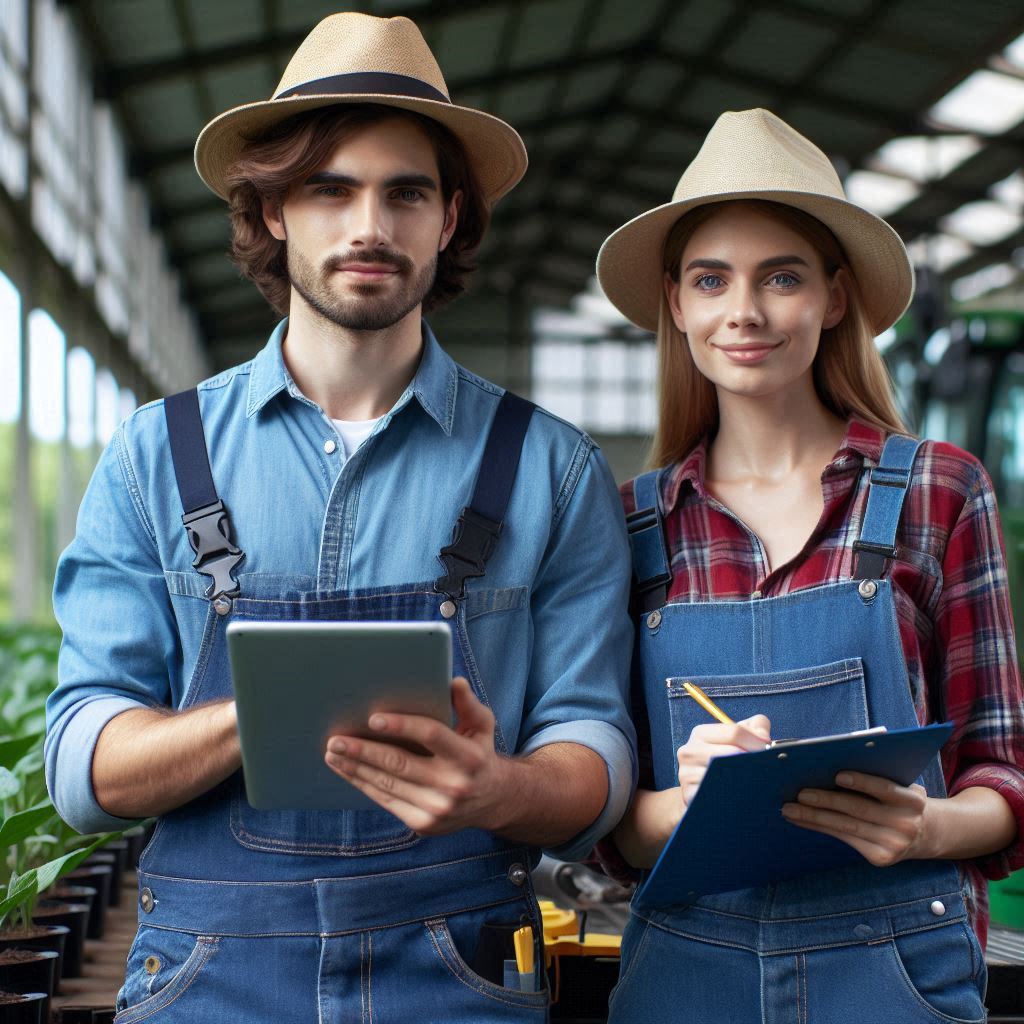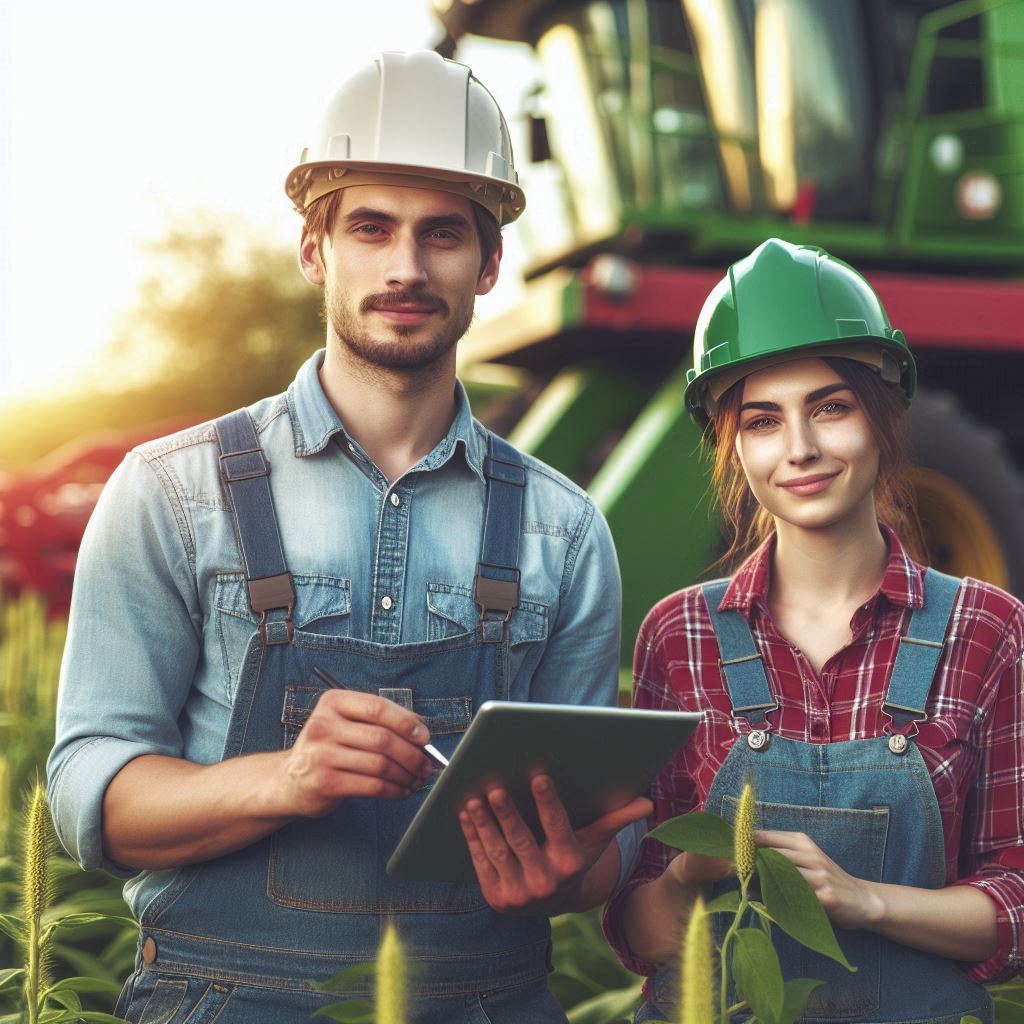Introduction
Emerging technologies in agricultural engineering are reshaping the farming landscape.
Innovations are driving efficiencies and boosting productivity.
Agriculture, a critical sector, is undergoing rapid transformation.
Technology plays a vital role in this evolution.
Understanding these advancements is crucial for embracing the future of farming.
Agricultural engineering combines engineering principles with agricultural science.
The goal is to improve farming practices and outcomes.
New technologies are central to this mission.
They address challenges and open new possibilities.
Farmers can now harness technology to optimize their operations.
Technological advancements are revolutionizing agriculture in multiple ways.
Precision agriculture uses GPS and data analytics to enhance crop management.
Drones and satellites provide real-time data on crop health and soil conditions.
This data allows farmers to make informed decisions and apply resources more efficiently.
Automation is another game-changer in agriculture.
Robots now handle tasks like planting, weeding, and harvesting.
This reduces labor costs and increases precision.
Automated systems can work around the clock, improving productivity and consistency.
Artificial intelligence (AI) is making a significant impact.
AI algorithms analyze vast amounts of data to predict trends and optimize practices.
Machine learning models help in detecting pests and diseases early.
Drones
How Drones Are Used in Precision Agriculture
Drones are transforming precision agriculture by offering new ways to monitor and manage crops.
These unmanned aerial vehicles (UAVs) fly over fields, capturing high-resolution images and collecting data from above.
Farmers use this aerial data to gain insights into crop health and field conditions.
Drones equipped with advanced cameras and sensors can detect issues such as pest infestations, nutrient deficiencies, and disease outbreaks.
They provide real-time data, allowing farmers to address problems quickly.
This technology supports precision farming by enabling targeted interventions and reducing the need for broad-spectrum treatments.
Benefits of Using Drones in Monitoring Crop Health and Field Conditions
The benefits of using drones in agriculture are considerable.
First, drones save time and labor compared to traditional field inspections.
Farmers no longer need to walk through fields or use manual tools to assess crop conditions.
Drones efficiently cover large areas and provide detailed, accurate data.
Second, drones deliver high-resolution imagery and data, offering precise information about crop health.
This allows farmers to make informed decisions and respond to issues promptly.
Drones help in monitoring crop growth over time, facilitating adjustments to farming practices as needed.
Third, drones improve field mapping and monitoring.
They create detailed maps that assist in planning irrigation and fertilization.
By applying resources where they are most needed, drones help reduce costs and minimize environmental impact.
The ability to track progress and evaluate crop performance enhances overall farm productivity.
Examples of Companies Utilizing Drones in Agriculture
Several companies are at the forefront of utilizing drones in agriculture.
DJI offers the Agras series, designed for crop spraying and field monitoring.
These drones are equipped with advanced sensors and cameras to deliver precise data and applications.
PrecisionHawk provides a range of drones and software solutions focused on data collection and analysis.
Their technology captures high-resolution imagery and uses analytics to optimize farming operations.
Parrot is another key player, with their Bluegrass series specializing in agricultural data collection.
Their drones create detailed field maps and assess crop health.
SenseFly offers fixed-wing drones ideal for extensive farms.
Their technology delivers accurate, actionable data, enhancing crop management over large areas.
Drones are revolutionizing agricultural engineering by improving precision and efficiency.
With advancements in drone technology, their role in agriculture will continue to expand, driving innovation and sustainability in the industry.
practices by providing farmers with valuable insights and actionable data.
Artificial Intelligence
How AI is Being Integrated into Agricultural Machinery and Equipment
Artificial Intelligence (AI) is revolutionizing agricultural engineering by seamlessly integrating with modern machinery and equipment.
AI enhances tractors, drones, and irrigation systems, making them more intelligent and efficient.
Autonomous tractors, equipped with AI, navigate fields with precision, reducing human intervention.
Drones powered by AI provide real-time aerial imagery, enabling detailed analysis of crop health and field conditions.
Smart irrigation systems use AI to analyze weather data and soil moisture, optimizing water usage and minimizing waste.
These AI-powered advancements ensure more accurate, efficient, and automated farming practices, transforming traditional agriculture.
Benefits of AI in Predicting Crop Yields and Optimizing Farming Practices
AI’s ability to predict crop yields is a game-changer in agriculture.
By analyzing historical data, weather forecasts, and soil conditions, AI provides accurate yield predictions.
This predictive capability helps farmers make informed decisions about planting and resource allocation.
AI algorithms analyze vast amounts of data to recommend optimal planting times, crop varieties, and nutrient management strategies.
These insights lead to more efficient farming practices, higher crop yields, and reduced resource consumption.
AI-driven systems also monitor and adjust farming practices in real-time, ensuring optimal conditions for crop growth and overall farm productivity.
Case Studies of AI Applications in Agriculture
Case studies highlight the transformative impact of AI in agriculture.
In California, AI-enhanced irrigation systems have significantly reduced water usage while boosting crop yields.
These systems use AI to analyze soil moisture and weather data, adjusting irrigation schedules to meet crops’ needs precisely.
Another case involves AI-driven drones used for pest management.
These drones employ image recognition technology to detect pest infestations early, allowing for targeted interventions and reducing the need for widespread pesticide use.
Autonomous harvesters also showcase AI‘s benefits by operating with minimal human input, improving efficiency, and cutting labor costs.
These examples demonstrate how AI applications drive innovation, efficiency, and sustainability in agriculture, addressing challenges and enhancing productivity across the industry.
Read: Top Cities for Electrical Engineering Jobs in America
Robotics
Robotics plays a crucial role in mechanizing farming tasks to increase efficiency and productivity in agriculture.
Robots are being increasingly used in various stages of farming, including planting, harvesting, and maintenance of crops.
Overview of the role of robotics in mechanizing farming tasks
Robots are designed to perform repetitive tasks efficiently and accurately, reducing the need for manual labor in agriculture.
They can work around the clock, in any weather conditions, and with precision that surpasses human capabilities.
Robotic technology in agriculture is revolutionizing the industry by automating tasks that were once labor-intensive and time-consuming.
By using robots for farming operations, farmers can improve productivity and reduce operational costs.
Advantages of using robots in planting, harvesting, and maintenance of crops
One of the key advantages of using robots in agriculture is the increased speed and efficiency they bring to farming tasks.
Robots can work faster than humans, resulting in quicker planting, harvesting, and maintenance of crops.
Robots also improve accuracy in planting and harvesting, ensuring that crops are planted at the right depth and harvested at the peak of ripeness.
This precision leads to higher yields and better quality crops.
Using robots in agriculture can also help address labor shortages in the industry.
As the labor force in agriculture continues to decline, robots can fill the gap and ensure that farming operations can continue without interruptions.
Examples of robotic technologies being used in agriculture
One example of robotic technology being used in agriculture is the autonomous tractor.
These self-driving vehicles can perform tasks such as plowing, seeding, and spraying crops without the need for human intervention.
Another example is the robotic harvesting system, which uses computer vision and robotic arms to carefully pick fruits and vegetables.
These robots can work faster and more efficiently than human labor, reducing the time and labor required for harvesting crops.
Robots are also being used for weeding and pest control in agriculture.
Autonomous robots equipped with cameras and sensors can identify weeds and pests in the field and apply targeted treatments, reducing the need for chemical inputs and manual labor.
Essentially, robotics is transforming the agriculture industry by automating tasks, increasing efficiency, and improving productivity.
As technology continues to advance, we can expect to see more innovative robotic solutions in agriculture that will revolutionize the way we farm.
Read: From Intern to Lead: Climbing the Software Ladder in the US
Internet of Things (IoT)
How IoT Devices Are Enhancing Farm Management and Decision-Making
The Internet of Things (IoT) is transforming agricultural engineering with advanced technology.
IoT devices are revolutionizing farm management and decision-making by providing real-time data and insights.
These devices, including sensors and smart equipment, collect and transmit data from various sources across the farm.
This continuous flow of information helps farmers make better decisions and optimize their operations.
For example, IoT sensors monitor critical parameters like soil moisture, temperature, and nutrient levels.
This real-time data allows farmers to adjust irrigation schedules and fertilization plans based on current conditions.
IoT technology also integrates with farm management software, enabling comprehensive analysis and visualization of data.
This integration helps farmers identify trends, forecast needs, and implement precise agricultural practices.
By leveraging IoT devices, farmers can enhance productivity, reduce waste, and achieve better overall farm management.
Transform Your Career Today
Unlock a personalized career strategy that drives real results. Get tailored advice and a roadmap designed just for you.
Start NowBenefits of IoT in Monitoring Soil Conditions, Water Usage, and Livestock Health
IoT technology offers numerous benefits in monitoring soil conditions, water usage, and livestock health, leading to more efficient and sustainable farming practices.
- Monitoring Soil Conditions: IoT sensors placed in soil measure moisture levels, temperature, and nutrient content. This data is crucial for optimizing irrigation and fertilization. Accurate soil information helps prevent overwatering and minimizes fertilizer use, leading to healthier crops and reduced environmental impact. Farmers can also use soil data to tailor their crop management strategies, enhancing yields and conserving resources.
- Managing Water Usage: Smart irrigation systems equipped with IoT technology adjust water supply based on real-time soil moisture data. This automated approach ensures that crops receive the right amount of water at the right time, reducing water waste and improving water efficiency. By monitoring weather conditions and soil moisture, these systems can also anticipate irrigation needs, making water management more precise and effective.
- Improving Livestock Health: IoT devices such as wearables and health sensors track livestock health and behavior. These sensors monitor vital signs, movement patterns, and feeding habits. Early detection of health issues enables timely veterinary intervention, reducing the risk of disease outbreaks and minimizing veterinary costs. IoT technology also enhances animal welfare by providing farmers with detailed insights into their livestock’s well-being.
Success Stories of IoT Implementation in Agriculture
Several success stories illustrate the transformative impact of IoT in agriculture, showcasing its potential to enhance farm operations and improve outcomes.
- California Farm: A farm in California implemented IoT sensors to optimize irrigation practices. By analyzing real-time soil moisture data, the farm reduced water usage by 30%. This not only led to significant cost savings but also contributed to more sustainable water use practices. The success demonstrated how IoT technology can lead to both economic and environmental benefits.
- Wisconsin Dairy Farm: In Wisconsin, a dairy farm adopted IoT wearables for monitoring cows. These sensors tracked the health and behavior of the livestock, leading to early detection of health issues. The farm reported a 20% increase in milk production and a reduction in veterinary expenses. This success story highlights how IoT can enhance animal health and productivity.
- Iowa Farm: An Iowa farm utilized GPS-enabled sensors for precision agriculture. The technology provided detailed mapping of crop fields, guiding planting and harvesting decisions. As a result, the farm achieved a 15% increase in crop productivity. This example underscores the value of IoT in optimizing crop management and boosting yields.
These success stories reflect the growing impact of IoT in agriculture.
By integrating IoT technology, farmers can achieve more efficient, sustainable, and productive farming practices, demonstrating the technology’s potential to revolutionize the industry.
Read: Exploring Architect Salary Trends: USA Analysis.

Learn More: Benefits of Being a Laboratory Technician
Blockchain
How Blockchain Technology is Improving Transparency and Traceability in the Food Supply Chain
Blockchain technology is revolutionizing agricultural engineering by enhancing transparency and traceability.
It provides a secure and immutable ledger where data cannot be altered once entered.
Each transaction in the supply chain is recorded, from farm to table, ensuring that consumers and stakeholders have access to accurate and tamper-proof information.
This level of transparency helps build trust among consumers and stakeholders by confirming the integrity of the entire food supply chain.
Advantages of Using Blockchain to Verify Product Authenticity and Ensure Food Safety
Blockchain technology offers significant advantages in verifying product authenticity and ensuring food safety.
Consumers are increasingly concerned about the origins of their food.
Blockchain allows for real-time tracking of food products, providing detailed records of every step in the supply chain.
This capability enables consumers to verify the authenticity of products easily.
Additionally, if a food safety issue, such as contamination, arises, blockchain records help trace the source quickly.
This rapid traceability minimizes the risk of widespread contamination and ensures prompt responses, enhancing overall food safety.
Case Studies of Blockchain Applications in Agriculture
Several case studies illustrate the effectiveness of blockchain in agriculture.
A prominent example is the collaboration between Walmart and IBM, which uses blockchain to track food products from farms to stores.
This system has drastically reduced traceability time.
For instance, Walmart decreased the traceability time of mangoes from 7 days to 2.2 seconds.
Another notable example is De Beers and Everledger’s partnership.
De Beers employs blockchain to track the provenance of diamonds, ensuring they are ethically sourced.
Similarly, this approach is being adapted for agricultural products to guarantee authenticity and ethical sourcing.
Blockchain also improves supply chain efficiency.
The AgriDigital platform, for example, uses blockchain to streamline transactions between farmers, buyers, and processors.
This digital solution cuts down on paperwork, accelerates transactions, and lowers costs.
Overall, blockchain technology enhances transparency, verifies product authenticity, and ensures food safety in agricultural engineering.
Its continued adoption will further reshape the food supply chain, making it more reliable and efficient.
Producers alike.
Read: 5 Essential Software Tools Every US Architect Uses.
Discover More: How to Stay Updated as a Cybersecurity Analyst
Nanotechnology
Overview of How Nanotechnology is Being Utilized to Improve Crop Protection and Nutrient Delivery
Nanotechnology is revolutionizing agricultural engineering by providing innovative solutions for crop protection and nutrient delivery.
This technology operates at the nanoscale, manipulating materials at the atomic and molecular levels to create highly effective tools for farming.
Nanoparticles, due to their tiny size, can be engineered to encapsulate pesticides and fertilizers.
This encapsulation protects the active ingredients, allowing for controlled and sustained release.
For instance, nanoparticles can slowly release pesticides over time, reducing the frequency of application and minimizing environmental impact.
Similarly, nanoparticles in fertilizers improve the efficiency of nutrient delivery.
They penetrate plant tissues more effectively, ensuring that essential nutrients are available precisely where needed.
This targeted approach enhances plant growth, leading to healthier crops and better yields.
Benefits of Using Nanotechnology in Reducing Chemical Use and Increasing Crop Yields
The benefits of nanotechnology in agriculture are substantial, particularly in reducing chemical use and increasing crop yields.
Traditional farming often relies on high quantities of chemicals, which can lead to environmental degradation and increased costs.
Nanotechnology addresses these issues by enhancing the efficiency of pesticides and fertilizers.
By reducing the overall amount of chemicals needed, nanotech minimizes the environmental footprint of agriculture.
This reduction also leads to cost savings for farmers, who can achieve the same or better results with fewer inputs.
Additionally, nanotechnology contributes to increased crop yields.
Enhanced nutrient delivery ensures that plants receive essential nutrients in optimal amounts, promoting stronger and healthier growth.
Improved pest control through nanotech means fewer crop losses due to disease or pests.
These factors collectively lead to higher yields, which are crucial for meeting the demands of a growing global population while maintaining sustainable farming practices.
Examples of Nanotech Innovations in Agriculture
Several examples of nanotech innovations illustrate the transformative impact of this technology in agriculture.
One notable innovation is nano-sized seed coatings.
These coatings protect seeds from pathogens and pests while promoting better germination rates.
They provide a protective layer that delivers essential nutrients directly to the seedling as it begins to grow.
Another significant advancement is the development of nano-enabled sensors for soil monitoring.
These sensors offer real-time data on soil conditions, such as moisture levels and nutrient content.
This data allows farmers to make informed decisions and adjust their practices to optimize crop growth.
Smart delivery systems represent another promising application of nanotechnology.
These systems release fertilizers and pesticides in response to specific environmental conditions, ensuring that the right amount of active ingredients is applied at the right time.
This method reduces waste and maximizes the effectiveness of each treatment.
These examples demonstrate how nanotechnology is driving innovation in agriculture, offering new tools for improving efficiency, sustainability, and crop productivity.
Conclusion
Importance of emerging technologies in agricultural engineering cannot be overstated.
These innovations have the potential to significantly improve farming practices.
By adopting these technologies, farmers and industry professionals can enhance efficiency, productivity, and sustainability in their operations.
It is vital to embrace and implement these advancements in order to stay competitive in the agricultural sector.
As we look to the future of farming, it is clear that emerging technologies will play a pivotal role in shaping the industry.
From precision agriculture to automation, these innovations have the power to revolutionize how we produce food.
It is imperative for farmers and industry professionals to stay abreast of the latest developments and actively incorporate these technologies into their practices.
By doing so, they can not only improve their own operations but also contribute to the overall advancement of agriculture as a whole.
Therefore, the call to action is clear – embrace, adopt, and leverage the potential of emerging technologies in agricultural engineering.
By doing so, we can create a more efficient, sustainable, and productive future for farming.




